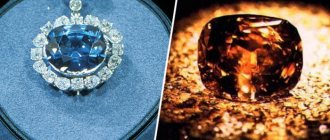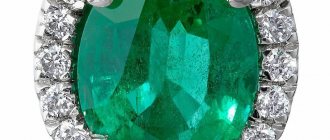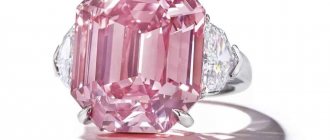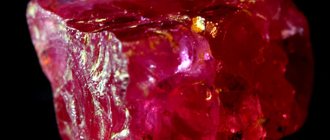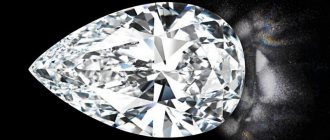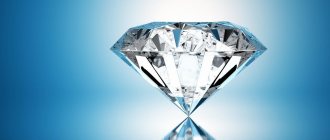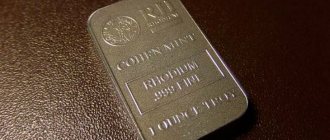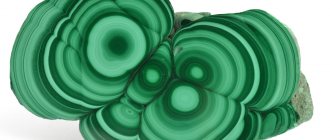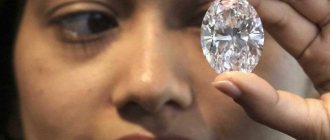Recently, a friend from Moscow boasted to me that she bought a black diamond weighing two carats for only $15,000. Her joy was short-lived: black diamonds, which jewelry companies have been trying with all their might to present in recent years as a new trend in the world of beauty, are technical stones the lowest quality. The red price is $250-400 per carat.
There are very few people in the world who understand diamonds, and even fewer who know a lot about colored stones. Unscrupulous traders take advantage of this when they sell a “unique” champagne or cognac colored stone to an unprepared consumer for 10-20 times more than its real value. I want to talk about the main principles for choosing colored stones that will help you avoid being deceived.
The Orange Diamond
$35.5 million
A unique diamond of incredibly intense bright orange color weighing 14.32 carats was auctioned at Christie's in November 2013. The stone belonged to an unknown collector for more than 30 years, and when it was put up for sale, it was valued at $35.5 million, thereby setting two value records at once. Firstly, it became the most expensive orange diamond. And secondly, it became the diamond with the highest cost per 1 carat.
Advertising - Continued below
What colors do diamonds have?
All diamonds can be divided into two large categories - colorless and colored. Diamonds, the raw material for diamonds, were created by nature millions of years ago. This is a product of crystallization of carbon molecules under high pressure and exposure to enormous temperature. During the process of crystallization, the stone could, figuratively speaking, “catch” various impurities and become colored. Colored diamonds are found in nature much less frequently than colorless diamonds. Only 0.01% of diamonds in nature are “fancy”, that is, colored.
Advertising on Forbes
The undisputed leader in uniqueness, rarity and price among colored diamonds is red. The auction price for such a diamond starts at $1 million per carat. The largest diamond, a rare red color, weighs just over five carats. The presence of red color in a diamond is due to deformations in its crystal lattice caused by high pressure during the natural formation of a diamond. Next is the green fancy diamond. A diamond receives this color as a result of natural radioactive radiation that has penetrated deep into the diamond. The blue color in a diamond is indicated by the presence of the chemical element boron. What makes a diamond orange and yellow is when it enters the crystal lattice of the chemical element nitrogen.
Pink Diamond Princie
$39.3 million
In addition to the undeniable beauty of this soft pink diamond weighing 34.65 carats, the news associated with it is not only the successful sale at a fantastically high price. 2 years after the sale, which took place in 2013, the Christie's auction house was sued by the alleged real owners of the stone, demanding the return of the gem and compensation for moral damages. Details of the story can be found in the article.
Colored diamonds
Gem-quality colored diamonds are much rarer than colorless diamonds. While colorless diamonds are mined several million times a year, colored diamonds with bright pure colors are mined in the first tens. Their color can be yellow, orange, cognac, purple, green, pink, red, blue or blue.The Diamond Fund in the Kremlin exhibits two fancy diamonds: a blue one weighing 7 carats and a pink one weighing 3.36 carats, as well as several yellow and brown diamonds. Diamonds in colors such as red, pink, orange, purple, blue, cyan, and green are often more expensive than colorless diamonds in the highest color group. The high cost makes such stones available exclusively to a narrow circle of very wealthy buyers. It is therefore not surprising that there are only a few companies worldwide that specialize in fancy colored diamonds. In 2003, the Smithsonian Institute of Natural History in the United States demonstrated a unique exhibition of fancy diamonds, for which stones had to be borrowed one by one from the collections of major companies.
In the center is a colorless Millennium Star diamond (203.04 carats). From left to right: Steinmetz Pink (59.60 carats), Heart of Eternity (27 carats), Pumpkin Diamond (5.54 carats), Moussaieff Red (5.11 carats), Ocean Dream, Allnatt (101.29 carats).
The owner of Millennium Star and Heart of Eternity is De Beers. Steinmetz Pink is owned by and named after the Steinmetz Group. Moussaieff Red was cut for Moussaieff Jewelers Ltd. A diamond named Allnatt is named after its owner, the famous philanthropist Alfred Ernst Allnatt
The cost of colored diamonds is immensely high and can reach $1 million per carat if the stone has a natural color. Fancy diamonds have such a huge value primarily due to their rarity. Colored diamonds are so specific that many of the laws of the regular diamond market do not apply to them. They need to be cut according to different rules, graded using different systems, and sold differently than regular diamonds. There are no price lists or price lists for fancy colored diamonds because... There are too few transactions with them for statistical processing of prices. Additionally, small variations in coloration result in significant price jumps. For example, red and pink diamonds can experience a sharp decline in value if they develop a brown tint. Conversely, if the main color is brown, then the value may jump up if an orange tint appears. For blue and cyan diamonds, a gray tint is undesirable, and for green diamonds, a yellow tint is undesirable.
In order to get an idea of the price levels prevailing in the colored diamond market, dealers and gemologists usually collect information about actual transactions with these stones, primarily based on the results of auctions at Sotheby's and Christie's.
Sometimes in the catalogs of these auctions, in preparation for the sale of a colored diamond, transaction prices for other similar stones are given. The most expensive fancy deep yellow (vivid) diamonds
| Price $ per carat | Cut | Purity | Date of sale | Auction | ||
| 13.83 | 3 302 500 | 238 792 | marquis | VS1 | April1997 | Sotheby's |
| 11.75 | 1 888 214 | 160 699 | oval | VS1 | November 1997 | Sotheby's |
| 9.12 | 1 652 500 | 181 195 | rectangle | VS1 | April 1998 | Christie |
| 9.35 | 1 067 813 | 114 205 | diamond | VVS2 | November 2000 | Phillips |
| 13.75 | 976 000 | 70 982 | emerald | VVS1 | October 1999 | Sotheby's |
| 9.22 | 969 860 | 105 191 | oval | VVS2 | November 2000 | Sotheby's |
| 10.03 | 946 400 | 94 357 | cushion | IF | April 1999 | Christie |
| 13.98 | 893 500 | 63 913 | rectangle | VS2 | April 1998 | Christie |
| 12.24 | 882 500 | 72 100 | oval | IF | April 1996 | Sotheby's |
| 9.38 | 855 000 | 91 151 | pear | VS1 | April 1998 | Sotheby's |
| 9.05 | 772 500 | 85 359 | pear | IF | April 1995 | Sotheby's |
| 20.03 | 655 750 | 32 738 | pear | VS2 | April 2000 | Sotheby's |
| 22.65 | 555 050 | 24 506 | cushion | VS1 | November 1999 | Sotheby's |
| 10.23 | 497 500 | 48 631 | emerald | VVS2 | October 1995 | Sotheby's |
At different times, different colors of diamonds have enjoyed varying degrees of popularity around the world.
In the nineteenth century and at the beginning of the last century, blue diamonds were most popular. The famous 42.5-carat blue Hope Diamond is considered the most expensive small object in the world, valued at $200 million, or just under $5 million per carat. Currently, it is difficult to say which color of stone is more popular. For example, starting in the 1970s, when diamond deposits were discovered in Australia, pink, cognac, wine, lilac and red diamonds from the Argyle mine began to be promoted to the market. Now the cost of such stones reaches $100 thousand per carat. The price of red, green and blue diamonds ranges between $400-$500 thousand per carat. In December 2001, a 1.92 carat VS2 red round cut diamond sold for $1.65 million. Fancy Blues (intense fancy blues +40% to +50%)
| FL-VVS | VS | S.I. | I1 | |
| 1/2 carat | 60.000-65.000 | 40.000-60.000 | 30.000-40.000 | 20.000-25.000 |
| 3/4 carat | 70.000-80.000 | 50.000-75.000 | 40.000-50.000 | 30.000-35.000 |
| 1 carat | 120.000-140.000 | 100.000-120.000 | 85.000-100.000 | 70.000-90.000 |
| 2 carats | 175.000-225.000 | 150.000-200.000 | 125.000-175.000 | 50.000-90.000 |
| 3 carats | 250.000-375.000 | 225.000-350.000 | 200.000-275.000 | 125.000-175.000 |
| 4 carats | 300.000-400.000 | 275.000-375.000 | 225.000-300.000 | 150.000-200.000 |
| 5 carats | 400.000-550.000 | 375.000-525.000 | 300.000-400.000 | 200.000-250.000 |
Fancy pinks (intense fancy pinks from +40% to +50%)
| FL-VVS | VS | S.I. | I1 | |
| 1/4 carat | 15.000-30.000 | 12.000-25.000 | 11.000-22.000 | 5.000-10.000 |
| 1/2 carat | 35.000-50.000 | 30.000-45.000 | 20.000-45.000 | 10.000-15.000 |
| 3/4 carat | 40.000-55.000 | 35.000-60.000 | 25.000-40.000 | 15.000-20.000 |
| 1 carat | 60.000-80.000 | 50.000-70.000 | 40.000-70.000 | 25.000-35.000 |
| 2 carats | 100.000-135.000 | 75.000-100.000 | 60.000-90.000 | 30.000-40.000 |
| 3 carats | 155.000-250.000 | 125.000-200.000 | 90.000-130.000 | 75.000-100.000 |
| 4 carats | 175.000-250.000 | 175.000-225.000 | 125.000-150.000 | 85.000-110.000 |
| 5 carats | 250.000-350.000 | 200.000-300.000 | 150.000-300.000 | 150.000-225.000 |
Are black diamonds fancy?
The situation with black diamonds requires a separate discussion. Until recently, the raw material for their production - black diamonds - was considered exclusively technical, i.e. such diamonds were sorted into the “edge” position. The cost of such raw materials did not exceed $10 per carat. However, some part of such raw materials is suitable for cutting, namely those crystals in which the black color is evenly distributed throughout the volume. Not all experts agree that a cut black diamond can be called a diamond, because it is opaque, does not sparkle or “play,” and is capable of reflecting light only on its surface. It is clear, however, that the trade term "black diamond" is valid in the sense that the use of this term cannot be prosecuted.
There are much fewer black diamonds than colorless (or almost colorless) diamonds, so black diamonds and jewelry with them began to be positioned as unique and quickly occupied their market niche. They are popular, in particular, among men, many of whom are far from the idea of decorating themselves with colorless diamonds and appearing in public in this form. The cost of black diamonds is much lower than colored ones, and there is a category of buyers who can afford black ones, but cannot afford (or even find on the market) colored ones. In addition, due to the low cost of raw materials, operations with black diamonds are more profitable for cutters, dealers and jewelers than operations with colorless diamonds.
However, in addition to the positive aspects described, the black diamond market also has negative ones. Since many experts are skeptical about them, the owner of black diamonds may feel deceived if he finds out that he “bought a board”, or “overpaid”, because they are “not diamonds at all” and “belong to the very last group according to technical specifications, or do not comply with the specifications at all.” The second problem is that black diamonds can harm the high market reputation of colored diamonds by competing for their role. The third problem is gentrification. The growing popularity of black diamonds has sparked a new round of refining technologies, and in particular, firms have emerged that can “blacken” low-quality, defective diamonds by irradiation or annealing. In turn, gemological laboratories are looking for ways to diagnose traces of refining of such stones and publish research results in scientific gemological periodicals. Another problem is that under the guise of a black diamond, the buyer may be given artificial black moissanite.
Russian market
Russia produces almost all of its diamonds from deposits in the Republic of Sakha-Yakutia. In these deposits, of the fantasy colors, only yellow and brown are found. Therefore, the Russian market of colored diamonds and polished diamonds suffers from a shortage of raw materials. Russian jewelers sensed before cutters that there was a demand for fancy-colored diamonds in the country. However, the first blue and bright yellow diamonds they purchased abroad were almost all refined, which, naturally, foreign sellers did not report. Following the lead of jewelers, cutters and dealers saw the opportunities that colored diamonds offered, and naturally colored diamonds appeared on our market. They note an increase in demand from cutters for yellow and brown rough diamonds. Gradually, the market realized that a colored diamond should be accompanied by a gemological expert report. This conclusion must reflect two circumstances: the natural origin of the stone and the natural origin of the color. Some laboratories, such as GTL GIA, have a separate form for an expert opinion on a fancy colored diamond.
Evaluation Features
What do you need to know to avoid being deceived when trading colored diamonds? Firstly, there is a high probability that the stone may be synthetic or refined. It is easier to synthesize a large diamond crystal with a thick yellow-brown color than a colorless one. Therefore, any yellow, tan or brown diamond should be checked for natural origin. Artificial color-changing technologies available today make it possible to change the color of a natural crystal to a more attractive one, for example, green or bright yellow. Since refining does not leave obvious traces in the stone, special equipment and diagnostic techniques are required. Therefore, diagnostic problems are usually solved in gemological laboratories, and the expert opinion of a recognized laboratory is a guarantee of the authenticity of the stone and its color.
Once there is no doubt about the authenticity of the stone and its color, you need to decide on its characteristics, the most important of which is color. The technical requirements in force in Russia are not easy to apply to color assessment. Such rare colors as pink, blue or green, according to the technical specifications, belong to the first color group, and this is incorrect, because the cost of stones of such colors significantly exceeds the cost of diamonds of the first color group.
Regarding yellow diamonds, the technical specifications indicate that they can be classified as fancy if they are more saturated than a special stone - sample (color standard 8-5). In international practice, the color of ordinary diamonds is characterized by a letter designation from D to Z, depending on the saturation of yellow, and the color of stones yellower than the Z standard is described using the term fancy. In this case, the 8-5 standard may not correspond to the last color in the international color rating scale.
Depending on the hue and saturation, fancy stones are assigned colors: light yellow, yellow, intense yellow, vivid yellow, etc. When moving from one gradation to another, the cost jumps up sharply. And if the main color of the diamond is not yellow or brown, but, for example, blue or pink, then the stone can be considered fancy if its saturation is higher than that of the K color sample.
According to research by CNN/Money, the second place among the “objects of desire” of millionaires is occupied by jewelry with precious stones and, in particular, the most fashionable recently, jewelry with colored diamonds. Cutting colored diamonds is a profitable and promising activity. The chain along which the stone moves from the deposit to the consumer is minimal. Mining companies try to sell all the colored diamonds they find directly to cutting companies, receiving maximum profit from the sale and not leaving it to intermediaries. Cutting companies, in turn, try to find a buyer for the diamond, and in most cases there is already one, and based on his request, the raw materials are searched and cutting is carried out.
Yuri Shelementyev, Petr Pisarev Gemological Center of Moscow State University
In preparing the review, the following materials were used: -Rapaport (August, 2004) -The Guide (May/June 2004) -Sotheby's Catalog (June, 2001) -www.fancycolors.ru https://www.nalogi.net
Apollo Blue Diamond
$42.08 million
Advertising - Continued below
Apollo Blue pear-shaped diamond weighing 14.54 carats
Apollo Blue and Artemis Pink Diamond Twin Pair
In May 2022, Sotheby's auction house sold a pair of colored diamonds, Apollo and Artemis, in the form of pendants for diamond earrings. Both diamonds certainly deserve a standing ovation, but in this article we will focus on the intensely blue stone, weighing 14.54 carats, called Apollo Blue.
The diamond became the largest flawless bright blue diamond in the history of the auction house and was sold for $42.08 million.
About the formation process and properties of blue diamond
Diamond is the hardest mineral on our planet. On the mineralogical scale it is rated 10. It is also considered the most transparent and the most expensive. It is also famous for its high ability to reflect color in faceted form.
Diamonds take several hundred years to turn blue. Boron penetrates into their crystal lattice, which gives the mineral a similar shade. The higher the content of this substance in a diamond, the more saturated its color.
Diamonds are made of carbon. Their color is determined by the admixture of other substances.
Since blue diamonds are extremely rare in nature, but the demand for them is constantly growing, people have learned to grow precious crystals in laboratory conditions. Such diamonds do not differ from natural stones in physical properties and look no less beautiful, but are much cheaper. It is impossible to independently distinguish the analogue from the original.
About the properties of diamonds, watch the lecture by the Doctor of Geological and Mineralogical Sciences:
Graff Pink Diamond
$46.2 million
Advertising - Continued below
The Graff Pink diamond was owned by Harry Winston before being auctioned at Sotheby's Geneva in 2010. The magnificent stone of intense fancy pink color and weighing 24.78 carats became at one time a record holder - the most expensive precious stone sold at auction. The diamond's new owner, Lawrence Graff, paid $46.2 million for it.
Blue Diamond Blue Moon of Josephine
$48.5 million
The sale of the bright blue diamond “Blue Moon” became a truly global event. And there were several reasons for this. The first is, of course, a unique color, which is extremely rare to find in a diamond. Even when the diamond was found, mining company Petra Diamonds called it “exceptional,” adding that the stone has “an outstanding, vibrant blue color of extraordinary intensity.”
Advertising - Continued below
Secondly, the weight of the Blue Moon of Josephine diamond was 12.03 carats, which is absolutely incredible for a blue diamond. And, of course, this fact greatly influenced the value of the stone (and, as a result, the price).
Thirdly, “Blue Moon”, which has a unique color and outstanding size, also boasts exceptional purity. Add to this the excellent cut - the last point of the famous 4C diamond grading system (Cut, Color, Clarity and Carat weight) - we can conclude that the gem was literally doomed to success.
Predictably, the Blue Moon of Josephine's price has made it the new record holder for the most expensive gemstone sold by Sotheby's.
Advertising - Continued below
Deposits of unique treasure
Blue diamond is an expensive and rare stone. There are only 2 undepleted deposits with such crystals in the whole world. And even in them only a few large specimens are mined per year.
Deposits of blue diamonds:
- South African Republic, Cullinan field;
- Australia, Argyle field.
The first deposit of blue diamonds was discovered in the 17th century in India. Indians treated rare stones with almost fanatical reverence.
But Indians were in no hurry to purchase jewelry for their collections. They believed that they were cursed by the god Rama, and inserted diamonds into the eye sockets of his idols to avoid the wrath of higher powers. The mineral was also mined for export.
The largest and most famous crystals were mined in Indian mines. At the moment the deposit is completely depleted.
In nature, stones are found in the form of large and small blocks. Even in their raw form they are absolutely transparent. After treatment, their ability to reflect light is significantly enhanced. Therefore, crystals from the mines are immediately sent to jewelers.
The larger the diamond, the higher its value. Therefore, the jeweler’s task when cutting is to preserve the maximum possible size of the jewelry.
It takes jewelers several months to cut some diamonds.
In addition, see the story about rare stones:
Oppenheimer Blue Diamond
$57.5 million
In second place, just a step away from Olympus, is the Oppenheimer Blue gem, sold by Christie's in May of this year. Everything that has been said about the magnificent Blue Moon in the case of Oppenheimer Blue should be raised to a superlative degree. Here is 14.62 carats of perfect color and impeccable clarity, framed in an incredibly capricious and demanding emerald cut.
The cost of the world's most expensive colored diamond was $57.5 million. The buyer was identified after 25 minutes of active trading, but his name remained unknown.
Advertising - Continued below
Blue diamond and its shades
Diamond is a mineral characterized by absolute transparency. Blue specimens have a greater ability to reflect color than other varieties. The stones shimmer in different colors in the sun.
The darker the blue mineral, the more expensive its cost. Depending on the saturation of the shade, blue minerals are divided into types:
- Faint;
- Veri Light;
- Light;
- Fancy Light;
- Fancy;
- Fancy Intent;
- Fancy Vivid;
- Fancy Deep.
The blue tint of light crystals is noticeable only in the sun. The color of darker crystals is visible even in a dark room. Cut diamonds have the inherent ability to reflect and refract light.
In the sun, in addition to the blue tint, the stone shimmers with red, purple and yellow tones.
View this post on Instagram
Posted by otlichnyyden (@otlichnyyden) Apr 25, 2022 at 9:21 am PDT
